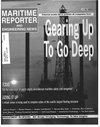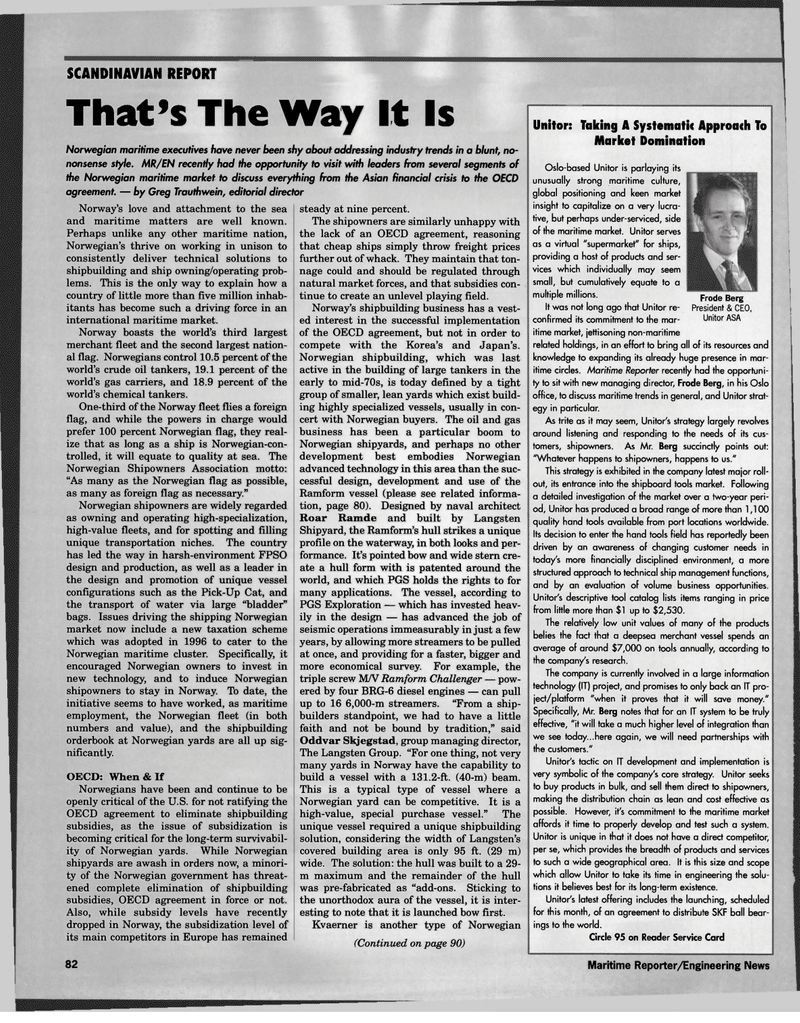
Page 90: of Maritime Reporter Magazine (April 1998)
Read this page in Pdf, Flash or Html5 edition of April 1998 Maritime Reporter Magazine
SCANDINAVIAN REPORT
That's The Way It Is
Norwegian maritime executives have never been shy about addressing industry trends in a blunt, no- nonsense style. MR/EN recently had the opportunity to visit with leaders from several segments of the Norwegian maritime market to discuss everything from the Asian financial crisis to the OECD agreement. — by Greg Trauthwein, editorial director
Norway's love and attachment to the sea and maritime matters are well known.
Perhaps unlike any other maritime nation,
Norwegian's thrive on working in unison to consistently deliver technical solutions to shipbuilding and ship owning/operating prob- lems. This is the only way to explain how a country of little more than five million inhab- itants has become such a driving force in an international maritime market.
Norway boasts the world's third largest merchant fleet and the second largest nation- al flag. Norwegians control 10.5 percent of the world's crude oil tankers, 19.1 percent of the world's gas carriers, and 18.9 percent of the world's chemical tankers.
One-third of the Norway fleet flies a foreign flag, and while the powers in charge would prefer 100 percent Norwegian flag, they real- ize that as long as a ship is Norwegian-con- trolled, it will equate to quality at sea. The
Norwegian Shipowners Association motto: "As many as the Norwegian flag as possible, as many as foreign flag as necessary."
Norwegian shipowners are widely regarded as owning and operating high-specialization, high-value fleets, and for spotting and filling unique transportation niches. The country has led the way in harsh-environment FPSO design and production, as well as a leader in the design and promotion of unique vessel configurations such as the Pick-Up Cat, and the transport of water via large "bladder" bags. Issues driving the shipping Norwegian market now include a new taxation scheme which was adopted in 1996 to cater to the
Norwegian maritime cluster. Specifically, it encouraged Norwegian owners to invest in new technology, and to induce Norwegian shipowners to stay in Norway. To date, the initiative seems to have worked, as maritime employment, the Norwegian fleet (in both numbers and value), and the shipbuilding orderbook at Norwegian yards are all up sig- nificantly.
OECD: When & If
Norwegians have been and continue to be openly critical of the U.S. for not ratifying the
OECD agreement to eliminate shipbuilding subsidies, as the issue of subsidization is becoming critical for the long-term survivabil- ity of Norwegian yards. While Norwegian shipyards are awash in orders now, a minori- ty of the Norwegian government has threat- ened complete elimination of shipbuilding subsidies, OECD agreement in force or not.
Also, while subsidy levels have recently dropped in Norway, the subsidization level of its main competitors in Europe has remained steady at nine percent.
The shipowners are similarly unhappy with the lack of an OECD agreement, reasoning that cheap ships simply throw freight prices further out of whack. They maintain that ton- nage could and should be regulated through natural market forces, and that subsidies con- tinue to create an unlevel playing field.
Norway's shipbuilding business has a vest- ed interest in the successful implementation of the OECD agreement, but not in order to compete with the Korea's and Japan's.
Norwegian shipbuilding, which was last active in the building of large tankers in the early to mid-70s, is today defined by a tight group of smaller, lean yards which exist build- ing highly specialized vessels, usually in con- cert with Norwegian buyers. The oil and gas business has been a particular boom to
Norwegian shipyards, and perhaps no other development best embodies Norwegian advanced technology in this area than the suc- cessful design, development and use of the
Ramform vessel (please see related informa- tion, page 80). Designed by naval architect
Roar Ramde and built by Langsten
Shipyard, the Ramform's hull strikes a unique profile on the waterway, in both looks and per- formance. It's pointed bow and wide stern cre- ate a hull form with is patented around the world, and which PGS holds the rights to for many applications. The vessel, according to
PGS Exploration — which has invested heav- ily in the design — has advanced the job of seismic operations immeasurably in just a few years, by allowing more streamers to be pulled at once, and providing for a faster, bigger and more economical survey. For example, the triple screw M/V Ramform Challenger — pow- ered by four BRG-6 diesel engines — can pull up to 16 6,000-m streamers. "From a ship- builders standpoint, we had to have a little faith and not be bound by tradition," said
Oddvar Skjegstad, group managing director,
The Langsten Group. "For one thing, not very many yards in Norway have the capability to build a vessel with a 131.2-ft. (40-m) beam.
This is a typical type of vessel where a
Norwegian yard can be competitive. It is a high-value, special purchase vessel." The unique vessel required a unique shipbuilding solution, considering the width of Langsten's covered building area is only 95 ft. (29 m) wide. The solution: the hull was built to a 29- m maximum and the remainder of the hull was pre-fabricated as "add-ons. Sticking to the unorthodox aura of the vessel, it is inter- esting to note that it is launched bow first.
Kvaerner is another type of Norwegian (Continued on page 90)
Unitor: Taking A Systematic Approach To
Market Domination
Oslo-based Unitor is parlaying its unusually strong maritime culture, global positioning and keen market insight to capitalize on a very lucra- tive, but perhaps under-serviced, side of the maritime market. Unitor serves as a virtual "supermarket" for ships, providing a host of products and ser- vices which individually may seem small, but cumulatively equate to a multiple millions.
It was not long ago that Unitor re- confirmed its commitment to the mar- itime market, jettisoning non-maritime related holdings, in an effort to bring all of its resources and knowledge to expanding its already huge presence in mar- itime circles. Maritime Reporter recently had the opportuni- ty to sit with new managing director, Frode Berg, in his Oslo office, to discuss maritime trends in general, and Unitor strat- egy in particular.
As trite as it may seem, Unitor's strategy largely revolves around listening and responding to the needs of its cus- tomers, shipowners. As Mr. Berg succinctly points out: "Whatever happens to shipowners, happens to us."
This strategy is exhibited in the company latest major roll- out, its entrance into the shipboard tools market. Following a detailed investigation of the market over a two-year peri- od, Unitor has produced a broad range of more than 1,100 quality hand tools available from port locations worldwide.
Its decision to enter the hand tools field has reportedly been driven by an awareness of changing customer needs in today's more financially disciplined environment, a more structured approach to technical ship management functions, and by an evaluation of volume business opportunities.
Unitor's descriptive tool catalog lists items ranging in price from little more than $1 up to $2,530.
The relatively low unit values of many of the products belies the fact that a deepsea merchant vessel spends an average of around $7,000 on tools annually, according to the company's research.
The company is currently involved in a large information technology (IT) project, and promises to only back an IT pro- ject/platform "when it proves that it will save money."
Specifically, Mr. Berg notes that for an IT system to be truly effective, "it will take a much higher level of integration than we see today...here again, we will need partnerships with the customers."
Unitor's tactic on IT development and implementation is very symbolic of the company's core strategy. Unitor seeks to buy products in bulk, and sell them direct to shipowners, making the distribution chain as lean and cost effective as possible. However, it's commitment to the maritime market affords it time to properly develop and test such a system.
Unitor is unique in that it does not have a direct competitor, per se, which provides the breadth of products and services to such a wide geographical area. It is this size and scope which allow Unitor to take its time in engineering the solu- tions it believes best for its long-term existence.
Unitor's latest offering includes the launching, scheduled for this month, of an agreement to distribute SKF ball bear- ings to the world.
Circle 95 on Reader Service Card
Frode Berg
President & CEO,
Unitor ASA 82 Maritime Reporter/Engineering News

 89
89

 91
91
